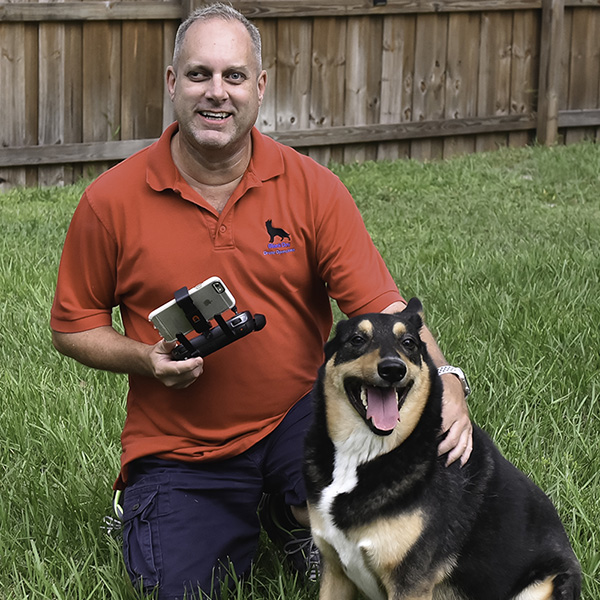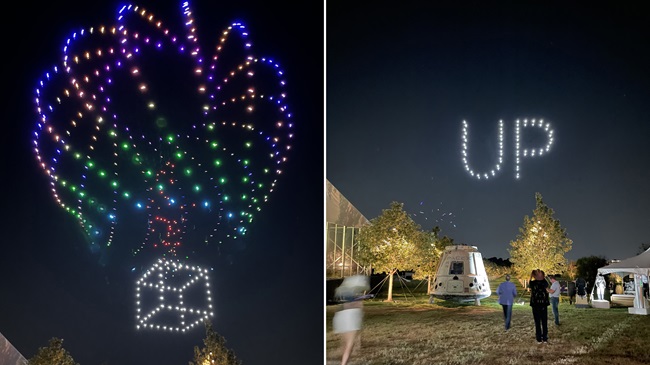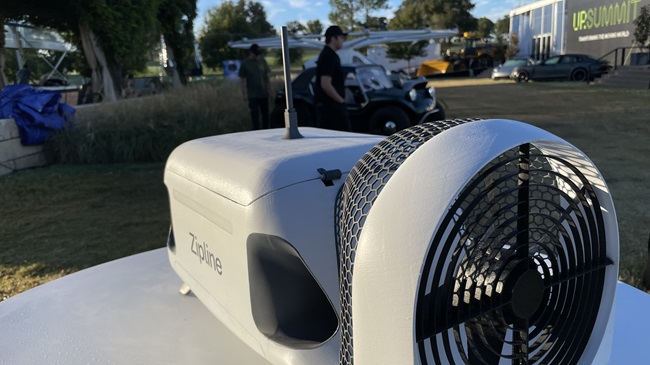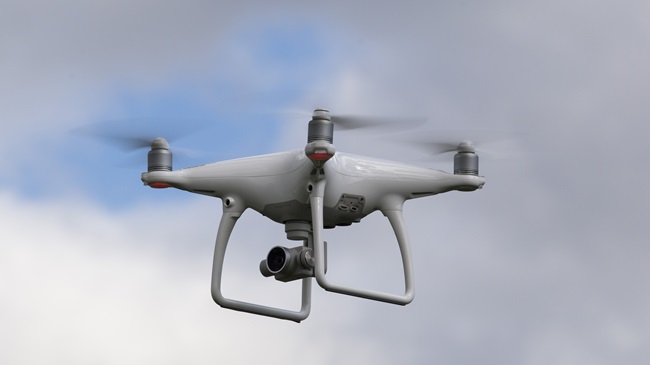Music in the air
Flying camera elevates music video
Take a look behind the scenes at how a drone shoot was planned, organized, and executed to take Liza Marie’s upcoming music video to the next level.
Drones are becoming more and more valuable to film and video production all the time. But what about even smaller productions, such as music videos? Being a smaller production does not make it any less professional.
Let’s go behind the scenes to examine some of the moving parts of how a music video production comes together.
Hello there!
Several months ago, I was contacted by Orlando, Florida, film producer Dale Metz of Dale Metz Productions to discuss adding aerial cinematography to a music video he was shooting for country pop artist Liza Marie. Ain’t Coming Back To Me is an impressive new song from Liza Marie and her production partnership with DMEOrlando, and tells the story of an off-and-on-and-off relationship between a young couple.
Metz had been following some of my articles for AOPA Drone Pilot and had seen other aerial film work I had done. Since he also has some experience with drones, he felt a few nice drone shots would be a perfect fit for this project and offered me the opportunity to work on this project. While the majority of the shoot would be ground based, aerial cinematography would be great for a climactic scene of the video.
The first part of any film project begins with an introduction and informational meeting. This is done to be sure everyone’s expectations are realistic and attainable. Sometimes the producer may be wanting something beyond the drone or operator’s capabilities, or even something that is not realistic at all. This is the time to lay all your cards on the table to be sure you can deliver the goods.
This is also the time to gather as much info about the shoot as possible: number of shots, script details, and very importantly, location information. Why is this so important? Well, you may have guessed by now that it is to determine any flight restrictions you may need to deal with. As always, there are no shortcuts to being professional. Always remember and adhere to FAA Part 107 regulations and avoid simply "winging it" to try to impress the producers. Not to sound like broken record, but it is worth repeating.
Once everyone is happy with the plan and any paperwork or contractual obligations, it is time to confirm a shoot schedule. I always like to suggest having an alternate shoot date with the producer. Keep in mind, you are going to be flying and filming outside. Stop and think about how much control you have over the weather, clouds, possible traffic, other onlooker interference, or literally a million other variables that could spoil any one scheduled shooting day. Having a second backup day can make or break an entire project, so try to encourage having an alternate as a safety net for unforeseen situations.
Pre-planning
So now what? You have the details for the shoot, you have a shooting date (and backup shoot date, just in case), but what now? Well, this is no time to sit around until the big day!
Metz and I had a number of conversations getting ready for the big shooting day, even going out for a demo flight a few weeks beforehand so he could see how the gear worked and see the image quality from the Autel Evo’s outstanding camera. This gave us time to work out any kinks and test the waters with plenty of time to adjust.
Dale provided me the coordinates for the shoot so that I could pull a Google map of the area as well as check for any required airspace authorizations. All good in a fairly remote Class G area. The map also gave me a great look at the clay road lined with gently sloping terrain on one side and a pretty lake on the other with minimal obstructions. So far, so good!
The day before the shoot was the normal routine. I made a list of needed gear, charged batteries, tested the controller, charged the controller display, and packed everything. I am fine with a little OCD creeping in during this part of the prep, so I tend to give things one last look right before heading out on the way to a shoot. You don’t want to spoil the whole thing by forgetting something like a silly (yet crucial) cable, right?
On set
We scheduled to be on set later in the afternoon to take advantage of the sun’s position near “golden hour” when the lighting is nice and warm. Plus, the imminent sunset would become a metaphor for a fading relationship.
I arrived a couple hours early. It is good to give yourself plenty of time to get acclimated to your shooting environment well before the hustle and bustle moves in. This being a remote clay road out in the country, there wasn’t much traffic or other clutter like that to avoid, but I didn’t take anything for granted. Surprise! All along one side of the road we would be shooting on ran a string of power lines that were not visible on the Google map. This now became a factor in deciding which flight path(s) to use and became something to be aware of and monitor.
Time for rehearsal
Before the actors and the crew were scheduled to show up, I wanted to have everything in place and figured out so that when they arrived it would be “places, ACTION!” Remember, this late in the day the sun would be fading fast, so maximizing time efficiency was critical. With several tightly planned shots, we wanted to keep the lighting as consistent as possible. In short, things had to go like clockwork.
Speaking of perfect timing, I had just received my brand-spanking-new DJI Mavic Mini, so I was going to put this little guy through some inaugural testing as the rehearsal drone. The Mavic Mini's small size, ease of handling, and excellent battery run time meant I could fly the course a number of times before pulling out the big gun Evo for the real shoot. I have to give DJI immense props on the Mavic Mini. Its image quality is superb and would suffice for many productions itself, believe it or not. The compact form, simple charging, and overall handling makes this a perfect backup drone for this sort of use, and it will be in my quiver for quite some time to come.
Action!
Once the cast and crew arrived and everyone was in place, it was time to roll cameras. Metz did his thing for the ground shots using his gimbal camera, and then it was time for the drone shots.
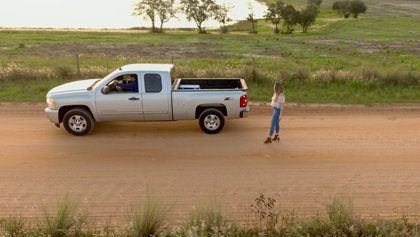
The scene was going to consist of a couple breaking up after an argument with the boyfriend hopping in his pickup truck and driving away down a dusty clay road, leaving poor Liza Marie in the distance.
I had set up a drone staging area about 75 feet behind the set. On set would be Liza Marie, the actor playing her boyfriend, and the pickup truck. But, before the props are spun up I always adhere to a my preflight checklist. One of the most important things is—you may have guessed it already—crew resource management. Remember that Part 107 pilots should already know this like the back of their hand and for the uninitiated, this means that everyone involved is aware of the flight, safety protocols, and to stay clear of the flight area at all times until it is called clear and the drone has landed and props stopped.
Remember, we were running on a tight schedule but getting in a hurry or cutting corners is never acceptable, nor is it professional. Worst case, you have to reschedule a shoot, but that is a far better compromise than risking potential property loss or injury.
Now, we had three shots to get.
The first shot would be the couple arguing beside the truck, and the boyfriend jumping in and driving off. We had decided on shooting this two different ways. The first is called a crane shot: The camera starts at a slight elevation of around 10 feet and rises straight up to about 50 feet as the truck drives away. This is a nice way to give a sense of growing distance while revealing the beautiful countryside looking roughly toward the setting sun.
The second variation was a bit different, yet similar. Starting in the same position behind the truck and off to the right side, the camera would rise slightly while following the truck down the road. This shot also gives the landscape reveal and a feeling of flying along with the truck, yet at a lower altitude. To add some emotion to the scene, as the camera follows the truck, we see Liza Marie dropping out of the bottom of the frame while we continue with the boyfriend, riding off into the sunset in his truck.
The third angle was more of a fill shot. This was a dolly shot moving past the side of the truck in a slight arc during the (ahem) conversation between the actors.
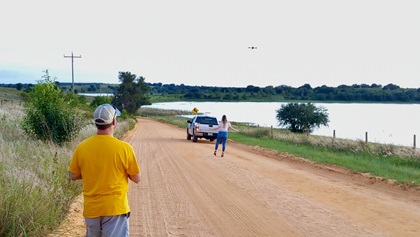
A few things to note here: It was desired to keep the truck as the focal point, particularly during the motion scenes. I accomplished this by using Dynamic Tracking in the Autel Explorer app. Don’t think this is just used for following moving objects (as I used it in the second shot). You can also lock onto an object and move the drone straight up or down, sideways, backwards, or simply keep it in place and it will keep the camera locked onto the subject beautifully. Of course, you can manually do this flying by the sticks, but it is a super nice feature and gives pro results worth exploring.
The second, more tricky part is about perspective. A shot like this needs to be somewhat close, but not too close to anyone. This means no flying over people, actors, crew, or anyone else. Going back to our rehearsal flights and proper planning, you can be sure to pick the right angles and distances to maintain top safety but still get some interesting angles. Always shoot in 4K to give yourself room to crop in postproduction to get the effect you need. Zooming and cropping are valuable skills to learn in your editing software.
That’s a wrap!
Smaller productions such as this are a fantastic outlet for creativity while adding so much production value to the final product. There are surely unique aspects to cinematography such as this, but the fundamentals always stay the same. Safety is always top priority, but with proper planning, taking plenty of time to frame and design your shots, good flying, and finally nice editing, your videos will be Oscar worthy before you know it!
If you would like to see the video for Ain’t Coming Back To Me, it is scheduled to be released sometime in early 2020, and you can follow Liza Marie on her website for more info and social media links.
